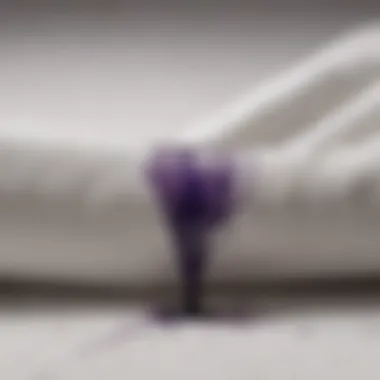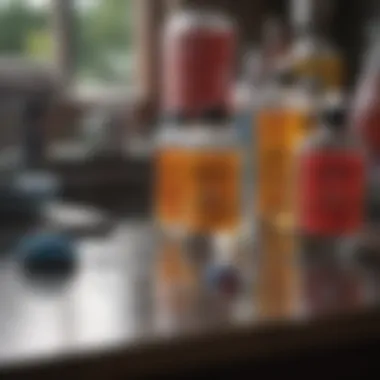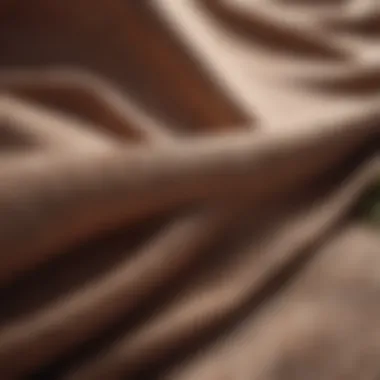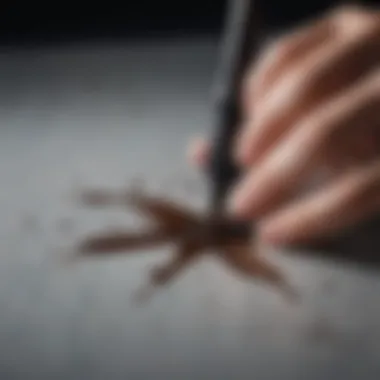Mastering Ink Removal: Your Guide to Ballpoint Stains


Intro
Ballpoint ink stains are an unfortunate reality for anyone who writes frequently or handles pens. These stains can be stubborn and, without timely intervention, can lead to permanent marks on various surfaces. This guide aims to provide practical, step-by-step methods for effectively removing ballpoint ink stains, tailored to different fabric types and the cleaning agents that work best for each. Being informed about how to handle these stains can significantly enhance one’s ability to maintain a clean and presentable environment.
Understanding Ink Stains
Before diving into removal techniques, it is essential to understand what causes ink stains and why they can be difficult to eliminate. Ballpoint pen ink is typically oil-based, making it adhere well to fabric fibers. This adherence is precisely why timely action is crucial once a stain occurs. The longer the ink sits, the more it penetrates the material, complicating its removal.
Key Points to Consider
- Timing: Address the stain as soon as possible.
- Fabric type: Different materials respond differently to cleaning agents.
- Cleaning agents: The choice of solvent or cleaner can determine success.
By acting quickly and knowing the best methods for specific fabrics, you increase the likelihood of complete stain removal.
Choosing the Right Cleaning Method
When it comes to stain removal, a one-size-fits-all approach seldom works. Selecting the right cleaning method depends on the type of fabric involved. Here are some general fabric categories and their associated cleaning methods:
- Cotton: Typically, a mixture of isopropyl alcohol and dish soap serves best.
- Silk: In this case, use a solvent like rubbing alcohol, but test on a small area first.
- Wool: You may find that a dry-cleaning solvent is the least damaging option.
- Synthetic fabrics: These often react well to stain removers specifically designed for ink.
Practical Steps for Stain Removal
- Blot the Stain: Use a clean cloth to gently blot – do not rub.
- Select Your Cleaner: Based on fabric type, choose among water, rubbing alcohol, or dish soap.
- Apply the Cleaner: Work from the outer edge towards the center.
- Rinse Thoroughly: Use cold water to flush out any remaining cleaner and ink.
- Launder: Follow up with machine washing, if appropriate.
Summary
Being informed about ink stain removal techniques is crucial for effective home maintenance. The methods discussed cater to various fabrics, ensuring that anyone can tackle ballpoint ink stains effectively. Readers are encouraged to approach each situation methodically and with the suggested cleaning agents. By doing so, maintaining a clean and presentable space becomes a manageable task.
Understanding Ballpoint Ink Stains
Ink stains can be quite an annoyance, especially when they appear on your favorite clothing or surfaces. Understanding ballpoint ink stains is essential to tackling them effectively. This section delves into the nature of ballpoint ink, its components, and the various surfaces it commonly affects, allowing readers to approach stain removal with greater confidence and knowledge.
Composition of Ballpoint Ink
Ballpoint ink is a complex mixture, primarily composed of pigments, solvents, and oils. The pigments provide the coloration, while the solvents dissolve the pigments and help the ink flow smoothly from the pen tip. Typically, the solvent is a type of oil, giving ballpoint ink its viscous consistency. Knowing these components is valuable for choosing the right cleaning agent. For instance, oil-based stains require substances that can break down oils effectively. Areal understanding of ballpoint ink's chemical makeup allows homeowners and individuals to make informed decisions when selecting cleaning methods.
Common Surfaces Affected
Ballpoint ink stains can affect a wide range of surfaces. Some of the most frequently impacted materials include:
- Fabric: Clothing, upholstery, and curtains are particularly susceptible, as fibers easily trap ink.
- Plastic: Items like phone cases or furniture can get stained if ink comes in contact with their surface.
- Wood: Ink on wooden surfaces can lead to undesirable blemishes, potentially damaging the finish.
- Paper: Though not always seen as a "stain," ink marks on important documents can be especially troublesome.
Each surface presents unique challenges for ink removal. Understanding these materials helps readers prioritize their cleaning efforts and select appropriate methods.
"Recognizing the nature of the ink and the materials affected is key to successful stain removal."
Through exploring the composition of ballpoint ink and the surfaces it can impact, readers gain a foundation for removing these pesky stains efficiently and effectively.
Immediate Actions After Ink Exposure
Taking immediate action after a ballpoint ink stain occurs is vital. The sooner you respond, the higher the chances of complete removal. Ink can quickly penetrate fibers, especially on fabrics, making the stain more aggressive if left unattended. The best strategy is to act swiftly but carefully.
Assessing the Damage


Before any cleaning begins, assessing the damage is crucial. Evaluate the depth of the stain and the type of material affected. Is it a light spot on a cotton shirt or a deep mark on a silk blouse? This evaluation helps in determining which cleaning method will be most effective.
Consider the following when assessing the stain:
- Fabric Type: Different fabrics respond differently to cleaning agents.
- Stain Size: Larger stains may require more thorough treatment than smaller ones.
- Time Elapsed: The longer a stain sits, the more difficult it is to remove.
Take care to examine the area closely and note its characteristics. This knowledge will guide you to choose the right cleaning technique.
Avoiding Common Mistakes
There are several common mistakes people make when dealing with ink stains. Avoiding these pitfalls can save time and minimize fabric damage.
- Rubbing the Stain: Rubbing can spread the ink further and push it deeper into the fibers.
- Using Hot Water: Hot water can set the ink, making it nearly impossible to remove. Always start with cool water.
- Ignoring the Care Labels: Many fabrics come with specific care instructions. Ignoring them can result in serious damage.
Remember that patience is key in stain management.
Following these guidelines and avoiding mistakes can significantly increase the likelihood of successful stain removal.
Preliminary Steps to Take
When encountering a ballpoint ink stain, the initial actions taken can greatly influence the outcome of the stain removal process. Before attempting any cleaning methods, it is essential to prepare adequately. This section will explore the key elements that make preliminary steps crucial and highlight specific considerations.
Gathering Necessary Tools
Before diving into cleaning, having the right tools at hand can make the process smoother. Individuals should collect items that are commonly effective in ink stain removal. This includes:
- Rubbing alcohol: A well-known solvent for breaking down ink components.
- Clean cloths or paper towels: Necessary for blotting and absorbing the ink.
- Dish soap: Useful in combination with water for treating fabric stains.
- Vinegar: Another solvent option that can help lift stains.
- Cornstarch: This can absorb moisture and can be a useful addition to some cleaning methods.
Having these tools ready can save time and prevent further damage to the material. It can be frustrating to realize that the correct solvent is not available during the stain removal process, leading to hasty or less effective remedies.
Testing on an Inconspicuous Area
Before applying any cleaning agent directly to the stain, it is prudent to conduct a test on an inconspicuous area of the item. This step serves multiple purposes. Firstly, it ensures that the cleaning solution does not further damage the fabric or surface. Different materials can react distinctively to various solvents.
For instance, a fabric might discolor when exposed to rubbing alcohol, while another might remain unaffected. Therefore, testing is vital. Here’s how to conduct this test:
- Select a Hidden Spot: Choose an area that is not easily visible. This could be a seam or a less prominent section of the fabric.
- Apply Small Amount: Using a cotton swab or a clean cloth, apply a small quantity of the cleaning solution.
- Wait and Observe: Allow the solution to sit for a short period before wiping it away gently. Observe any changes or reactions.
If no adverse effects are observed, proceed with confidence to treat the actual stain. If a negative response occurs, it would be wise to choose a different method or solution.
Remember: These preliminary steps are essential, and neglecting them can lead to irreversible damage to valuable fabrics or surfaces.
Methods for Fabric Stains
Understanding methods for removing ballpoint ink stains from fabric is crucial for maintaining the integrity of various textiles. These stains can be particularly stubborn if not treated properly, making prompt action essential. Different fabrics may respond uniquely to various cleaning agents. Therefore, knowing which methods to use can save not only your items but also time and effort. This article will discuss several effective techniques to tackle ballpoint ink stains, focusing on their specific applications and helpful tips.
Using Rubbing Alcohol
Rubbing alcohol is a favored method for tackling ink stains due to its powerful solvent properties. When faced with ballpoint ink, applying rubbing alcohol can effectively dissolve the pigment and lift it from the fabric. To start, place a clean cloth underneath the stained area to avoid spreading the ink. Dampen another cloth with rubbing alcohol and gently blot the stain. Work outward from the center to minimize spreading. This method is particularly effective on cotton and polyester blends, though caution is advised on delicate fabrics like silk.
Application of Dish Soap
Dish soap is not just for cleaning dishes; it can also assist in removing stains. It is a gentle yet effective cleaning agent that can break down oils in ink, making it easier to wash out. Mix a small amount of dish soap with warm water. Using a cloth or a sponge, apply the solution to the stain and lightly scrub. Rinse thoroughly with cold water afterward. This method is useful on various fabrics, including cotton and synthetic textiles, providing a less aggressive option for stain removal.
Utilizing Vinegar and Cornstarch


Combining vinegar and cornstarch creates another effective stain removal method. This mixture forms a paste that can draw out the ink. To use, mix one part vinegar with two parts cornstarch to create a thick paste. Apply this mix directly onto the stain and allow it to sit for at least 30 minutes. The paste will dry, and as it does, it helps to absorb the ink. Once dry, gently scrape it off and rinse the fabric with cold water. This method can be particularly effective for carpets and upholstery but is also suitable for other fabrics.
Commercial Stain Removers
When traditional methods do not yield the desired results, you might consider commercial stain removers specifically formulated for ink stains. These products often contain a blend of solvents designed for efficient stain removal. Always follow the instructions on the packaging, as some products may require specific application techniques or rinse intervals. Before using commercial products, it is wise to test them on an inconspicuous area of the fabric to avoid discoloration or damage. Brands like OxiClean and Zout are popular examples, known for their stain-fighting abilities.
"An immediate response to fabric stains is vital; delay often worsens the situation."
Incorporating these methods into your cleaning routine can greatly enhance your ability to manage ballpoint ink stains on various fabrics. Each technique has its strengths and weaknesses, making it essential to choose one based on the type of fabric and the nature of the stain.
Techniques for Hard Surfaces
When dealing with ballpoint ink stains, homeowners often overlook hard surfaces. These stains can occur on various materials, including countertops, floors, and walls. Understanding the proper techniques for removing these stains is crucial. Hard surfaces are often more resistant to stains compared to fabrics. However, if not addressed promptly, they can become stubborn problems. Moreover, improper cleaning methods can damage the surface, leading to costly repairs.
The methods discussed here will focus on two effective cleaning approaches. Using acetone is one such technique. It can break down the ink's structure, making it easier to wipe away. In addition, wiping with solvent-based cleaners can streamline the process, removing the stain without extensive scrubbing. Carefully applying these techniques can restore the affected area without causing additional harm.
Cleaning with Acetone
Acetone is a highly effective solvent for removing ballpoint ink stains from hard surfaces. This compound works by dissolving many types of inks, making it simpler for you to lift the stain. It is especially useful for surfaces like glass or tiles. However, homeowners must proceed with caution. Acetone can damage certain materials, such as plastics or painted surfaces.
To use acetone properly, follow these steps:
- Test the Surface: Before applying acetone, test it on a small, inconspicuous area. This ensures that the solvent won't damage the finish or material.
- Apply Acetone: Dampen a clean cloth or cotton ball with acetone. Avoid soaking it; too much acetone can spread the ink further.
- Blot the Ink: Gently blot the stained area. Do not rub, as this may cause the ink to penetrate deeper into the surface.
- Clean Up Residue: After the ink is removed, clean the area with warm, soapy water to remove any acetone residue. This step is essential for preventing damage to the surface.
- Dry Thoroughly: Finally, allow the surface to dry completely before using it again.
Wiping with Solvent-Based Cleaners
Solvent-based cleaners serve as another reliable method for cleaning ballpoint ink from hard surfaces. These products are specifically designed to break down various types of ink and stains. They come in many forms, including sprays and wipes. When selecting a cleaner, ensure it is suitable for the material of the surface you are cleaning.
To effectively use a solvent-based cleaner, follow this guide:
- Read Instructions: Always read the manufacturer's instructions before application. This provides important information about dilution and handling.
- Apply Product: Spray the cleaner directly onto the stained area or onto a cloth if more control is desired.
- Wipe the Stain: Gently wipe the area using a clean cloth. Repeat this process as needed until the ink stain is removed.
- Rinse the Surface: After the ink is gone, rinse the area with warm water to eliminate any cleaning residue.
- Dry the Surface: Use a clean, dry cloth to wipe the surface dry, preventing water marks.
"Using the right cleaning techniques can significantly improve your chances of successfully removing ink stains while preserving your surfaces."
Post-Cleaning Care
After successfully removing ballpoint ink stains, the importance of post-cleaning care cannot be overstated. This phase is crucial not only for ensuring complete stain removal but also for safeguarding the integrity of the fabric or surface. Proper care contributes to maintaining the material's color, texture, and overall appearance. Neglecting this step can lead to lingering residues or potential damage that undermines the effectiveness of earlier cleaning efforts.
Rinsing Procedures
Rinsing is a fundamental part of the post-cleaning process. It involves removing any cleaning agents or residues from the surface. Failing to rinse thoroughly can leave chemicals that may harm the material over time or attract dirt. To rinse effectively:
- Use Cold Water: Cold water is often recommended as it helps in preventing the staining agents from setting deeper into the fabric.
- Gently Flush the Area: This can be done under a faucet or using a clean sponge soaked in water.
- Repeat If Necessary: If there is still any trace of the cleaning agent or ink, repeat the flushing until the material feels clean.
It is valuable to remember that the rinsing process should not be rushed. Each piece should be dealt with carefully, ensuring all residues are adequately removed.
Drying Methods
Proper drying methods are essential in the post-cleaning care. How one dries a cleaned area can significantly affect the outcome. Here are important considerations for effective drying:
- Air Drying: If the material allows, air drying is the safest option. Lay the cleaned fabric flat on a clean surface or hang it to prevent any further creasing or damage.
- Use a Fan: For quicker drying, a fan can help circulate air around the area, promoting faster evaporation while minimizing heat exposure, which can sometimes set remaining residues.
- Avoid Direct Sunlight: Direct sunlight can sometimes cause fading or warping in certain materials.
In summary, post-cleaning care is an integral step in the overall process of removing ballpoint ink stains. Following the appropriate rinsing procedures and drying methods can help preserve the material and ensure the results of your cleaning efforts are long-lasting.


"Neglecting post-cleaning care can lead to unexpected issues, undermining previous stain removal efforts."
Dealing with Persistent Stains
Dealing with persistent stains requires a careful approach to ensure successful removal. Ballpoint ink stains can be particularly stubborn. Often, what seems like a clean surface may still hold remnants of ink, which can darken over time or spread if not addressed thoroughly. Understanding the methods available for persistent stains is essential for maintaining a clean and polished appearance in your home or work environment.
Reapplication of Cleaning Agents
Reapplying cleaning agents can often yield better results when dealing with persistent stains. Initial attempts may not fully lift the ink, leaving shadows behind. Here are some key points to consider:
- Selecting the Right Agent: Identify a suitable cleaning solution for the material affected. For fabric, consider rubbing alcohol or vinegar, but for hard surfaces, a solvent-based cleaner may work best.
- Application Technique: To maximize effectiveness, reapply the agent directly onto the stain. Use a clean cloth or sponge, and dab rather than rub. This method prevents further spreading of the ink.
- Repeated Treatment: Sometimes, multiple applications may be necessary. Allow each treatment to sit for several minutes to aid in breaking down the ink particles.
- Test Before Full Application: Always test on a discreet area first. This helps ensure that the cleaner does not damage the material.
When reapplying cleaning agents, patience and persistence are key. Many stains respond positively to repeated cleaning, especially if addressed promptly.
Professional Cleaning Services
In some cases, persistent stains resist all DIY attempts. This is where professional cleaning services come into play. They offer significant benefits, particularly when dealing with valuable or delicate items. Here’s why considering a professional is wise:
- Specialized Equipment: Professionals have access to specialized tools and cleaning solutions that might not be available for home use.
- Expert Knowledge: Trained cleaners understand the complexities of different materials, ensuring the correct method and solution is applied.
- Time Efficiency: Hiring professionals can save time. While you could spend hours trying to remove a stain, they may achieve results much quicker.
- Stain Protection Advice: Many cleaning services provide tips or solutions for preventing future stains once the current issue is resolved.
"In cases of persistent stains, professional help can sometimes be the best solution for both peace of mind and effective cleaning."
Deciding to employ professional services should weigh the value of the affected item against the potential cost. If the item is an expensive fabric or a sentimental piece, it may well be worth the investment.
Preventive Measures
Preventive measures play a crucial role in managing the threat of ballpoint ink stains on various surfaces. By proactively addressing factors that contribute to these stains, individuals can significantly reduce their occurrence. Understanding the preventive aspects also enhances the longevity of materials, saving time and effort related to cleaning tasks. Moreover, being aware of preventive strategies can help maintain an overall clean and appealing environment, crucial for homeowners and event hosts alike.
Choosing Appropriate Fabrics
The choice of fabric can greatly influence the potential for ink stain damage. Some materials are more resistant to staining than others. For instance, synthetic fabrics such as polyester are generally easier to clean and less susceptible to ink absorption compared to natural fibers like cotton or linen. Opting for blended fabrics often strikes a balance, combining durability with aesthetic appeal.
When purchasing or selecting fabrics for furniture or clothing, consider their resistance to stains. Fabric types treated with stain-resistant coatings can provide an extra layer of defense against ink and other spills. It's wise to avoid materials that easily absorb liquids due to their porous nature. In contrast, fabrics with tighter weaves may resist stains more effectively.
Additionally, it is practical to think about the context in which these fabrics will be used. For example, if entertaining guests or hosting events, consider using tablecloths and cushions made of easy-to-clean textiles.
Using Ballpoint Options Wisely
Using ballpoint pens comes with its own set of considerations. The ink within different brands can vary in terms of composition and permanence. Some inks may be prone to smearing or transferring onto fabrics more than others. It is important to select pens that are designed for minimal ink spread, particularly when used on surfaces prone to staining.
Another strategic approach involves being mindful of where these pens are utilized. When writing, prefer surfaces that are easily cleaned or utilize protective mats. If children are present, educate them on proper handling of ballpoint pens to mitigate unintended stains. It may also be beneficial to have a designated area for pen usage, preferably away from valuable fabrics or family heirlooms.
In addition, having a variety of writing instruments on hand can prevent incidents. For example, gel pens or pencils might be less likely to cause staining incidents in certain situations. Evaluating options and their context allows for better decision-making regarding the materials and environments that are at risk.
Remember: Prevention is always better than cure. Being proactive in your choices can save immense effort in cleaning later.
The End
As we wrap up this guide on removing ballpoint ink stains, it is essential to reflect on the significance of understanding and addressing these common issues. Ballpoint ink stains are not only unsightly but can also undermine the aesthetic appeal of textiles and hard surfaces in homes and workplaces. Tackling these stains effectively can bring a sense of order and cleanliness to one’s environment.
Recap of Key Points
In summary, we have explored various methods to eradicate ballpoint ink stains from different surfaces. Each technique, whether it involves using rubbing alcohol, soap, or commercial cleaners, comes with its own set of pros and cons. It is critical to assess the type of material affected and follow the right steps. Immediate actions after a stain ensures that the ink does not set. Testing any cleaning agent on an inconspicuous area helps avoid further damage, a vital strategy not to neglect. Also, the importance of preventive measures was emphasized, as choosing the right fabrics and being cautious with ballpoint pens can save a lot of trouble.
Final Thoughts on Stain Management
Managing ink stains extends beyond just cleaning; it's about adopting a proactive approach to minimize future occurrences. Homeowners and parties hosts can benefit from understanding how to manage their linens, upholstery, and other surfaces effectively. If professional cleaning is deemed necessary, recognizing when to seek help is also part of effective stain management.
"An informed approach not only solves problems but also enhances awareness and preparedness for future challenges."
In closing, the insights from this article equip you with practical knowledge, ensuring that ink stains do not become a permanent fixture in your life. Engaging with these cleaning strategies fosters a sense of accomplishment and control over how we maintain our living spaces.







